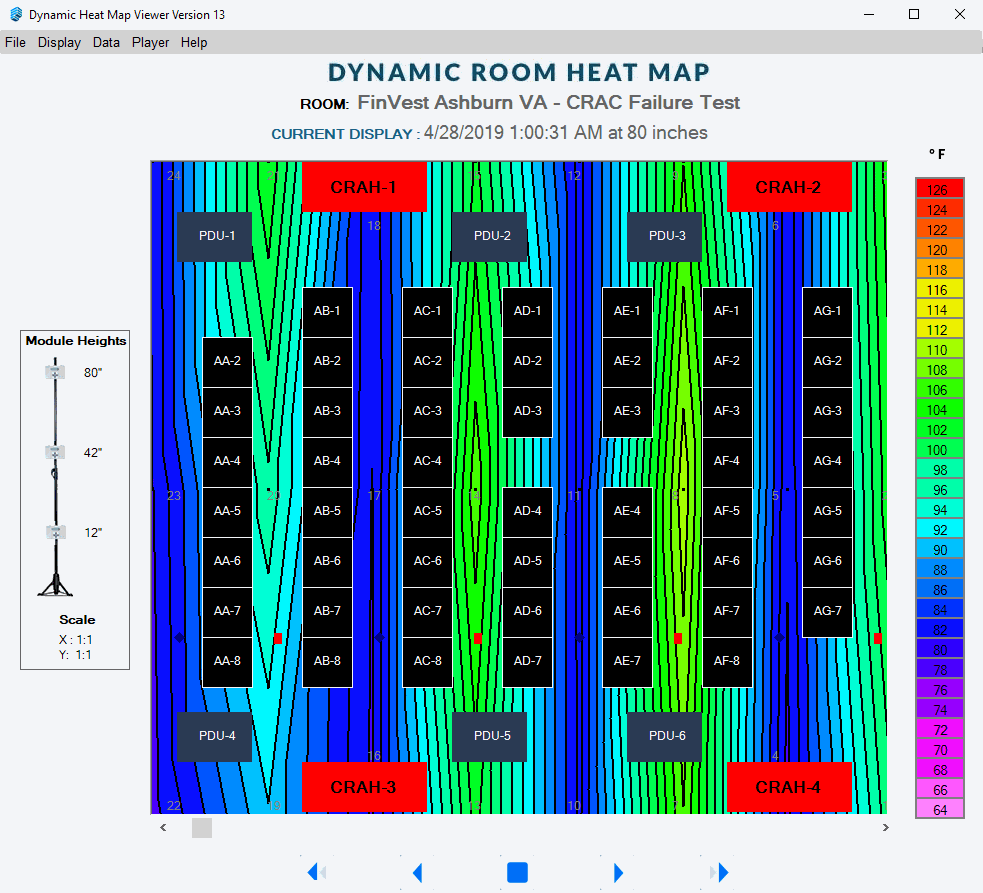How a Data Center Thermal Survey enhances CFD models.
Computational Fluid Dynamics (CFD) simulating potential airflow patterns within a data center and are helpful when designing a data center. But what happens when the data center goes live? Invariably the design from Day 1 changes, new servers are added, rack positions changed, tiles are added or removed — all of these impact the data center airflow. Operators need to keep this in mind when comparing their current operations to the original CFD. If you’re in this position, I would suggest considering conducting a thermal survey of your current environment. It can provide valuable information for enhancing the accuracy and effectiveness of a Computational Fluid Dynamics (CFD) model of a data center.
First, the best way to start is to compare what the CFD model predicted versus what’s actually happening today. You can use the survey data can be used to validate and calibrate the CFD model. By comparing the actual temperature measurements with the simulated temperatures from the model, you can ensure that the model accurately represents the real-world conditions.
Example: CFD Model and a Thermal Survey
PHOTO CREDIT: WWW.SEMANTICSCHOLAR.ORG
Purkay Labs Thermal Survey
Start by looking for hotspots. In both cases, the CFD and a thermal survey will show you the varying temperatures across the white space. By identifying the specific areas within the data center where temperatures are higher than desired, you’ll be able to spot potential issues. This information can be used to improve the CFD model's predictions and optimize the data center layout to eliminate or mitigate hotspots.
Then, start looking for the cold spots. The real-world temperature data from the survey can be used to optimize the settings of the data center's cooling systems in the CFD model. This includes adjusting the placement and configuration of air conditioning units, airflow patterns, and temperature setpoints to achieve better cooling efficiency.
The benefits of using the thermal survey to validate the original CFD include:
Energy Efficiency Improvements:
By incorporating survey data, the CFD model can be used to assess the energy efficiency of the data center. This can lead to recommendations for improvements in airflow management, equipment layout, and cooling strategies, ultimately helping to reduce energy consumption.
Scenario Analysis:
The survey data allows for the modeling of different scenarios, such as changes in server density, equipment configurations, or cooling system upgrades. This enables data center operators to evaluate the impact of potential changes before implementing them in the actual facility.
Risk Assessment:
Understanding the thermal conditions through a survey helps in assessing the risk of equipment overheating and potential failures. The CFD model can be used to simulate different failure scenarios and evaluate the impact on temperature distribution and cooling effectiveness.
Capacity Planning:
By combining survey data with CFD modeling, data center managers can perform more accurate capacity planning. This involves predicting how changes in IT load or equipment layout will affect cooling requirements, enabling proactive measures to accommodate future growth.
Continuous Monitoring and Adaptation:
Regular thermal surveys can be used to continuously monitor and update the CFD model. As the data center environment evolves over time, the model can be adjusted to reflect any changes, ensuring that it remains a reliable tool for decision-making.
In summary, integrating a Data Center Thermal Survey with a CFD model enhances the model's accuracy, improves operational efficiency, and helps in making informed decisions regarding the design and management of the data center's thermal environment.
Since 2012 Purkay Labs has been collecting and reporting Thermal Data to operators of Critical Spaces, not just data centers. Recognizing that resources are at a premium within most organizations Purkay Labs offers a full suite of onsite services to select from. You can always consider Purkay Labs to come in and conduct the thermal survey for you. You’ll get a comprehensive evaluation of your thermal environment. You can learn more here: https://www.purkaylabs.com/assessment-service
About the Author
Gregg Haley is a data center and telecommunications executive with more than 30 years of leadership experience. Most recently served as the Senior Director of Data Center Operations - Global for Limelight Networks. Gregg provides data center assessment and optimization reviews showing businesses how to reduce operating expenses by identifying energy conservation opportunities. Through infrastructure optimization energy expenses can be reduced by 10% to 30%.
In addition to Gregg's data center efforts, he has a certification from the Disaster Recovery Institute International (DRII) as Business Continuity Planner. In November of 2005, Gregg was a founding member and Treasurer of the Association of Contingency Planners - Greater Boston Chapter, a non-profit industry association dedicated to the promotion and education of Business Continuity Planning. Gregg had served on the chapter's Board of Directors for the first four years. Gregg is also a past member of the American Society of Industrial Security (ASIS).
Gregg currently serves as the Principal Consultant for Purkay Labs.



